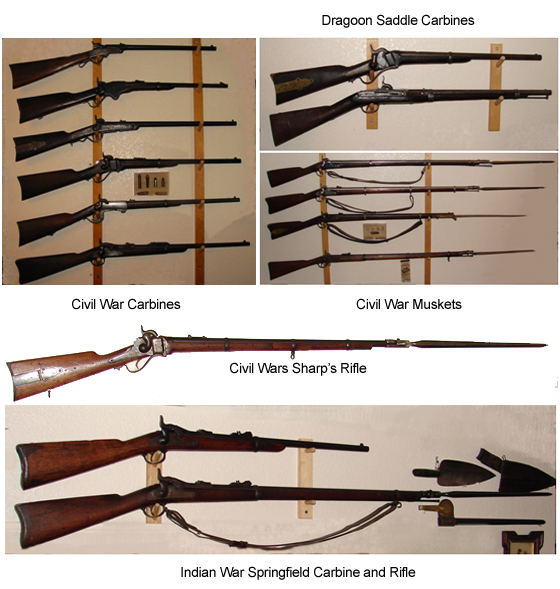Small Arms
Hand Guns
At the start of the Civil War Handguns were issued only to cavalrymen and mounted light artillery. As with everything else, a large variety of small arms were used, including obsolete weapons. The number of handguns privately purchased by Yankee soldiers easily exceeded the quantity issued by the Federal Government.
 At the end of the Civil War the Ordinance Department faced the same issues as the Quartermaster, with vast quantities of accoutrements and equipment in storage. These would continue in use until the early 1870's when several revolvers were converted to take a metallic cartridge. With the great westward expansion underway, this, in combination with the new self contained metallic cartridge, gave rise to a huge market, and demand for large bore frontier revolvers. Until Colt introduced their Calvary Model in 1873, the No.3 Smith and Wesson American, was the only large-caliber cartridge revolver used by the United States Government.
At the end of the Civil War the Ordinance Department faced the same issues as the Quartermaster, with vast quantities of accoutrements and equipment in storage. These would continue in use until the early 1870's when several revolvers were converted to take a metallic cartridge. With the great westward expansion underway, this, in combination with the new self contained metallic cartridge, gave rise to a huge market, and demand for large bore frontier revolvers. Until Colt introduced their Calvary Model in 1873, the No.3 Smith and Wesson American, was the only large-caliber cartridge revolver used by the United States Government.
In the late 1880's Colt began to experiment with double action revolvers. In 1892, the Army went to a .38 Caliber Colt double action Army (5 1/2" barrel) revolver. While the double action mechanism of this weapon was on the cutting edge of firearms technology, the Army learned in the Philippines that caliber .38 ammunition was not up to the task of stopping an attacking opponent in his tracks. In 1895 the Ordinance Department adopted the 5 1/2 -inch barrel for the service revolver, so the Calvary Model revolver, with it's 7 1/2" barrel was called in to have their barrels shortened.
Museum Examples

Following the end of the Civil War, the great westward expansion, was underway. This, in combination with the new self contained metallic cartridge, gave rise to a huge market, and demand for large bore frontier revolvers.
Rifles
At the start of the Civil War nearly all military arms were still loaded through the muzzle. The smoothbore long-arms were most  commonly known as muskets. The percussion ignition system took the place of the venerable flintlock and with the invention of the Minie ball; the newly “rifled” barreled arm soon became the practical weapon for all infantrymen. In 1860, B. Tyler Henry received a patent for a truly landmark rifle. With a lever operated action and the .44 Rim-fire brass cartridge case, the Model of 1860 or .44 Henry was born. This was a tremendously important firearms advancement coming at a time when the single-shot muzzle loader was it. Despite the repeaters’ tremendous popularity among the ranks, the Federal Ordinance Department purchased fewer than 15,000 in the last 2 years of the War.
commonly known as muskets. The percussion ignition system took the place of the venerable flintlock and with the invention of the Minie ball; the newly “rifled” barreled arm soon became the practical weapon for all infantrymen. In 1860, B. Tyler Henry received a patent for a truly landmark rifle. With a lever operated action and the .44 Rim-fire brass cartridge case, the Model of 1860 or .44 Henry was born. This was a tremendously important firearms advancement coming at a time when the single-shot muzzle loader was it. Despite the repeaters’ tremendous popularity among the ranks, the Federal Ordinance Department purchased fewer than 15,000 in the last 2 years of the War.
 The next important step was the advanced development of the breech loading shoulder arm (carbines). When the self-contained cartridge appeared in the mid-1800s, the problems of ignition and loading disappeared. With the breech-loader, it was a simple matter of putting a round into the chamber. The single shot carbine and the repeating rifle Army which appeared near the end of the Civil War, were used mainly by the Union.
The next important step was the advanced development of the breech loading shoulder arm (carbines). When the self-contained cartridge appeared in the mid-1800s, the problems of ignition and loading disappeared. With the breech-loader, it was a simple matter of putting a round into the chamber. The single shot carbine and the repeating rifle Army which appeared near the end of the Civil War, were used mainly by the Union.
In 1866 Winchester set the stage for a whole line of great lever guns by adding a forearm and a loading gate. In 1873 the now legendary Winchester '73 emerged differing from the 1866 in two major areas. The frame was now made of steel instead of brass, and the ammunition was no longer rim-fire but a re-loadable center-fire, the .44 Winchester Center Fire. The original chambering was joined by the .38 Winchester Center-fire in 1879, and this was followed by the .32 Winchester Center-fire in 1882. When Colt added these three cartridges to the Colt Single Action Army it became possible for a Cavalryman of that time to have a six-gun and saddle-gun that chambered the same cartridge. A most desirable feature.
Museum Examples
The carbine only differs from the rifle in the length of the barrel and stock and a few minor parts.














